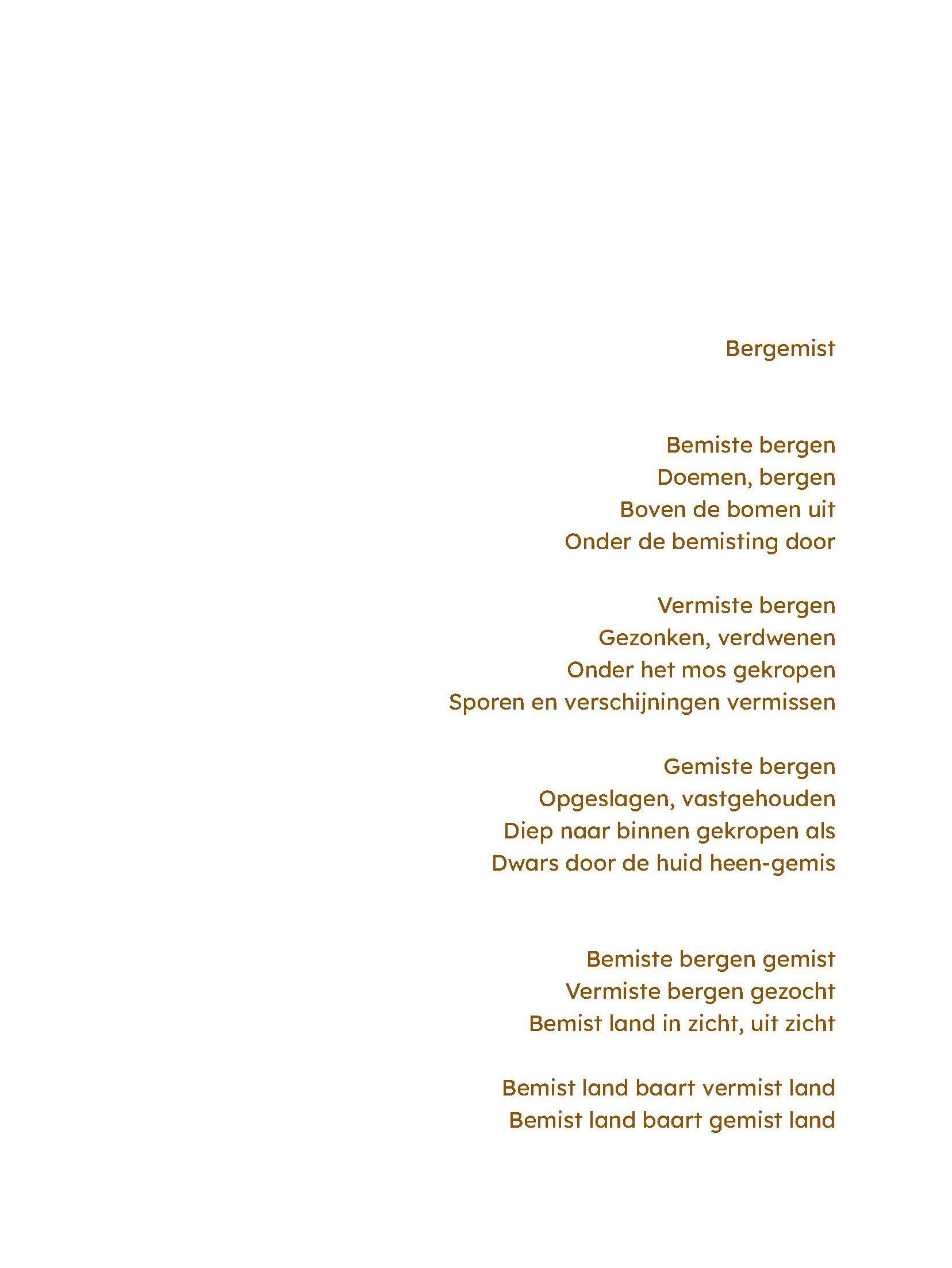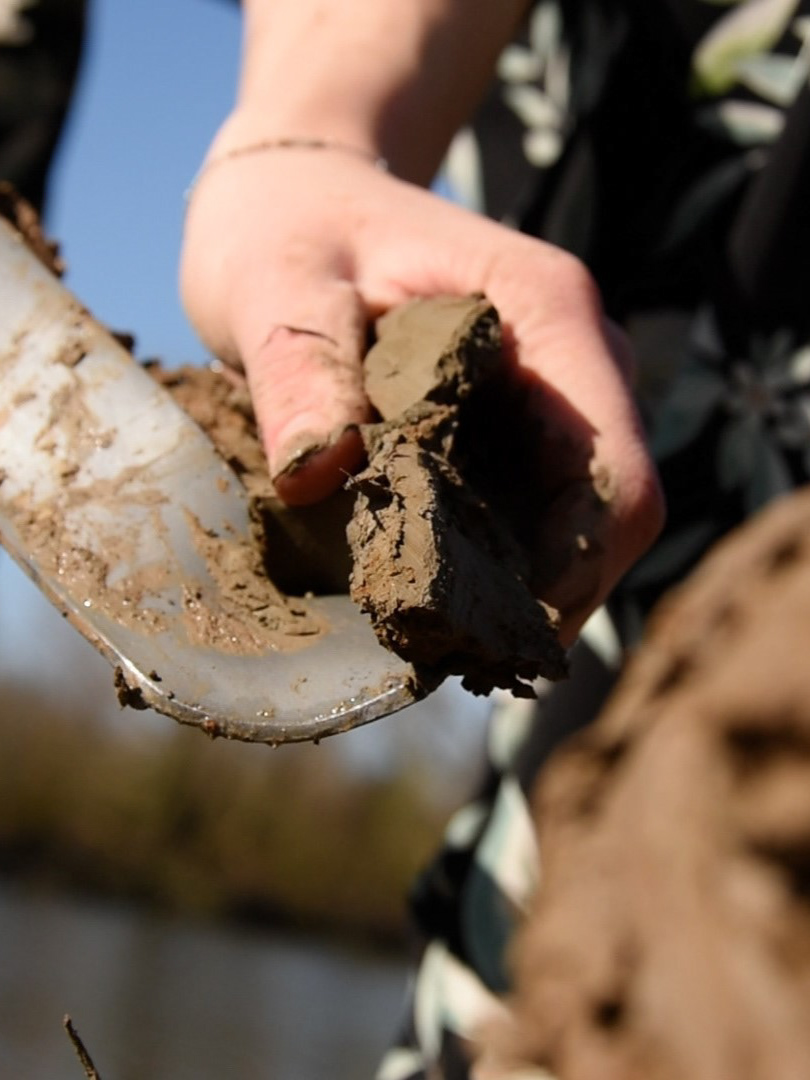Carmen Molenaar
01-2022
And, how are you today?
And after following the gravel path for quite some time, I decided to continue my way off track and into the dense forest. Since it was October, the damp ground was filled with contrasting colours of bright and dark green moss against the brown, sometimes yellow, leaves that had fallen off the trees. Rotting and soaked branches lay among small, not-long-ago-sprouted trees and beginnings of new shrubs. If you looked at the ground for long enough, in between all these others, you could see brown mushrooms popping up into you sight. ‘Hello there’, I said to a particularly shiny one, kneeling down to take a closer look. ‘And how are you today?’
In this writing, I would like to propose a different, more respecting and acknowledging attitude when it comes to speaking to and about non-human beings around us. To explain why this is important, I will first illustrate the problem of the current climate crisis and our problematic attitude that induced this crisis. Then, I will talk about how people verbally refer to non-human beings and the strong connection between language and worldview - how this causes communities speaking a different language, to act different. I will point out what we could learn from indigenous communities that have their respected worldview embedded in their language. Building onto this, I will stress the proposal of Dr. Robin W. Kimmerer to use the pronouns ki and kin when referring to non-human as well as human beings. I will end with my own proposal to approach also non-humans themselves, by using the pronoun you.
The realisation that we are in a planetary climate and nature crisis is strongly taking in by a growing number of people for the past decades. The term Anthropocene is used increasingly and is an unofficial unit for the geological time we are heading towards or are living in already - the debate on this is shifting towards the latter more and more. Anthropocene derives from the Greek language - antropo meaning man and cene meaning new - and this term is used to describe the planetary impact of human action on the climate and ecosystems.[1] These large-scale changes, mostly caused by extractive actions from western societies, are forming a threat to all (life) on the planet, and very much for humans ourselves. Nature will most probably restore herself perfectly fine over a long period of time, as she has done in the past. Whether we will be around by then, is up to us. It is up to us to change our mindset, as well as our behaviour; to shift from anthropocentrism to ecocentrism; to shift to a more respectful and thoughtful ethics and way of living, with an all-inclusive attitude towards all the living beings - human and non-human -, but also the non-organic beings.[2] Examples could be animals - from bugs to bunnies to bears -, plants - from grass to trees to moss-, and non-animate beings - from stones to streams to sand dunes-. I like to call them all beings, because - for example - rivers are being rivers just as much as humans are being humans. So, to help ourselves to start this shift, I think we should change the way we approach non-human beings. Physically, but also verbally. I would like to talk about the verbal part of this shift, because the way we talk about our world is closely related to our actions within it, and vice versa.[3]’[4]
So, let’s see how we refer to non-humans around us, in most modern western languages. In English we refer to non-humans using it. This is also the case is Dutch for example - my mother tongue -; we use the word het, which directly translates to it. This way of approaching seems very normal to us, as it did to me. Only until Dr. Robin W. Kimmerer asked the audience, when giving a lecture on finding common ground between scientific and indigenous knowledge, how it would feel if another human would refer to you by using it.[5] There is some kind of disrespect and downgrading the others position when using the pronoun it. Normally using this word for a non-human being, this would mean that there is a notion of disrespect build into the English language when one refers to a non-human. We see them as things, very often as things that are ours to use, control, manage. However, not all languages use the pronoun it when referring to a non-human being. What inspired me to write this piece is the different way most indigenous languages refer to non-humans. They often have two pronouns (animate and non-animate) or just one pronoun to refer to another and therefore do not make a division between human or non-human, gender, animate or non-animate. An example is Anishinaabemowin, an indigenous language mostly spoken in the west of Canada. They have just one pronoun to refer to another being: wiin, which loosely translates to (that) one in English.[6] Another great example is the Inuit language, Inuktitut, which uses the same word for all others, and even has the actor put into one word with the subject - it is a polysynthetic language - , drawing them even closer; like takajaru (taka meaning to see and jaru meaning I to the other (her/him/it/…).[7] In their language, and so in their attitude, they make no difference in stature between themselves and the non-human(s). When I look at the way indigenous communities live with their surroundings, the awareness of (the importance of) the non-humans around them is highly visible in their ways of living. I think we, those living in modern western settings, can learn a lot from them. And although most of us have not had the chance to meet indigenous communities personally (and we also shouldn’t storm into their lives!) documentaries like Down to Earth[8] can give us a great impression of the ways of living of indigenous communities (and may I take the freedom to strongly recommend you to watch this documentary).
So, if in English we only have the word it to refer to non-human beings, I say we are missing something important when trying to shift away from our human-centred view. Dr. Robin W. Kimmerer, whose family comes from the Potawatomi indigenous community, proposes to integrate new, inclusive pronouns into the English language to refer another being: ki, and in plural kin. These pronouns have the same attitude as the earlier mentioned indigenous languages; ki and kin are non-gendered, make no division between animate or non-animate and can be used for any human and non-human being. Because the word kin already exists in the English language (meaning family/tribe) the word has this connotation of connection to another built into it. Besides, the word ki relates vocally closely to the words he and she, and so this is a very fitting word to integrate into English.[9] With this we could start to describe others around us the same way many indigenous people do, aiming for changing our attitude and awareness along with it.
Yet, I would like to take it one step further. In my opinion we should not only talk about non-human beings differently, but also talk to them differently. Yes, talk to them directly. Because if we would only talk about them with our fellow humans, there is still this action of locking them out and not including them as much as we should. So, I would like to propose to approach all beings using the pronoun you, whether human or non-human. Pets are an example of how we use language differently when a non-human stands close to us. Lots of people talk about their pets using he/she/…, give them name, and approach them using the pronoun you. With this it is not the aim that we must draw every being as close to us as our pet, but it does shows us how attitude and language are intertwined when approaching other beings.[10] Another great example of approaching non-human beings is the Honourable Harvest Kimmerer talked about in her lecture. The honourable harvest is a harvesting method used by the Potawatomi community, consisting of multiple steps to follow while harvesting, with a great deal of respect for other beings embedded into it. One of the steps is asking the non-human being you approach, often plants in this case, if it is alright to take some and listen and wait for the answer.[11] This would imply that you ask them directly and I am a great advocator of this. Approaching non-human beings, using the pronoun you, allows us to take more time and recognize value in another being and can help us shifting towards a more ecocentric worldview.
So, after explaining how our attitude has been a great inducer of this current nature crisis, I hope to have stressed the importance of changing our anthropocentric attitude into an ecocentric one. We in western society could learn a lot from indigenous communities; from their language in which their respectful worldview is strongly embedded. Therefore, I would like to recommend you to take on the proposal of Dr. Robin W. Kimmerer to use the pronouns ki and kin for all beings. Along with that, I would endorse you to start approaching non-human beings by using the pronoun you.
And after walking without resting for quite some hours, I decided that it was time for a break. In the distance I saw some trees that were clearly planted by us, as they were standing in a very neat line. The second one to my left hand was catching a big ray of sunlight at the bottom, because of there was a small open piece of grassland next to the tree. ‘Hi, hello’, I thought quietly while taking of my backpack and lowered myself on the ground and roots, letting my back rest against the rigid trunk. I closed my eyes to let the sun charge my pale winter skin.
After a while, when the sun was starting to set and I had recharged myself a bit, I stood up to follow my way further down/back. I grabbed my backpack and before leaving, I let my hand rest on the bark of the tree and said softly ‘Thank you.’
[1] National Geographic Society. (2019). Anthropocene. National Geographic Resource Library. https://www.nationalgeographic.org/encyclopedia/anthropocene/, visited on 12-01-2022
[2] Patrick Curry. (2019). What is ecocentrism? (A definition). The ecological citizen. https://www.ecologicalcitizen.net/what-is.php?t=ecocentrism-definition. visited on 13-01-2022.
[3] Theodore Fontaine. 2015, Stolen Lives: The Indigenous Peoples of Canada and the Indian Residential Schools. Reading 5. Facing history and ourselves. https://www.facinghistory.org/stolen-lives-indigenous-peoples-canada-and-indian-residential-schools/chapter-1/language-and-worldview. visited on 14-01-2022.
[4] Yana Schottenstein. (date unknown). How the language you speak affects your worldview. Omniglot The online encyclopaedia of writing systems & languages. https://omniglot.com/language/articles/languageworldviews.htm. visited on 12-01-2022.
[5] Dr. Robin W. Kimmerer. (2017). The Teachings of Plants: Finding Common Ground Between Traditional and Scientific Knowledge. https://www.youtube.com/watch?v=ZAH_pqVMZ0Q&t=3538s. 38:20. visited on 14-01-2022.
[6] Lindsay Mocrom. (20190. Why Indigenous Languages Matter and What We Can Do to Save Them. TEDx talks. https://www.youtube.com/watch?v=g2HiPW_qSrs. 3:30. visited on 14-01-2022.
[7] Janet Tamalik McGrath. Sila. Matthew Schneider-Mayerson and Brent Ryan Bellamy (editors). (2019). An Ecotopian Lexicon. University of Minesota press. p 258.
[8] DOWN to EARTH collective. (2020). DOWN to EARTH. https://www.youtube.com/watch?v=FlTODxalakI.
[9] Dr. Robin W. Kimmerer. (2017). The Teachings of Plants: Finding Common Ground Between Traditional and Scientific Knowledge. https://www.youtube.com/watch?v=ZAH_pqVMZ0Q&t=3538s. 41:55. visited on 14-01-2022.
[10] Arianna Rebolini. (2017). Why Do Humans Talk to Animals If They Can’t Understand?. The Atlantic. https://www.theatlantic.com/health/archive/2017/08/talking-to-pets/537225/. Visited on 14-01-2022
[11] Dr. Robin W. Kimmerer. (2017). The Teachings of Plants: Finding Common Ground Between Traditional and Scientific Knowledge. https://www.youtube.com/watch?v=ZAH_pqVMZ0Q&t=3538s. 49:15. visited on 14-01-2022.




